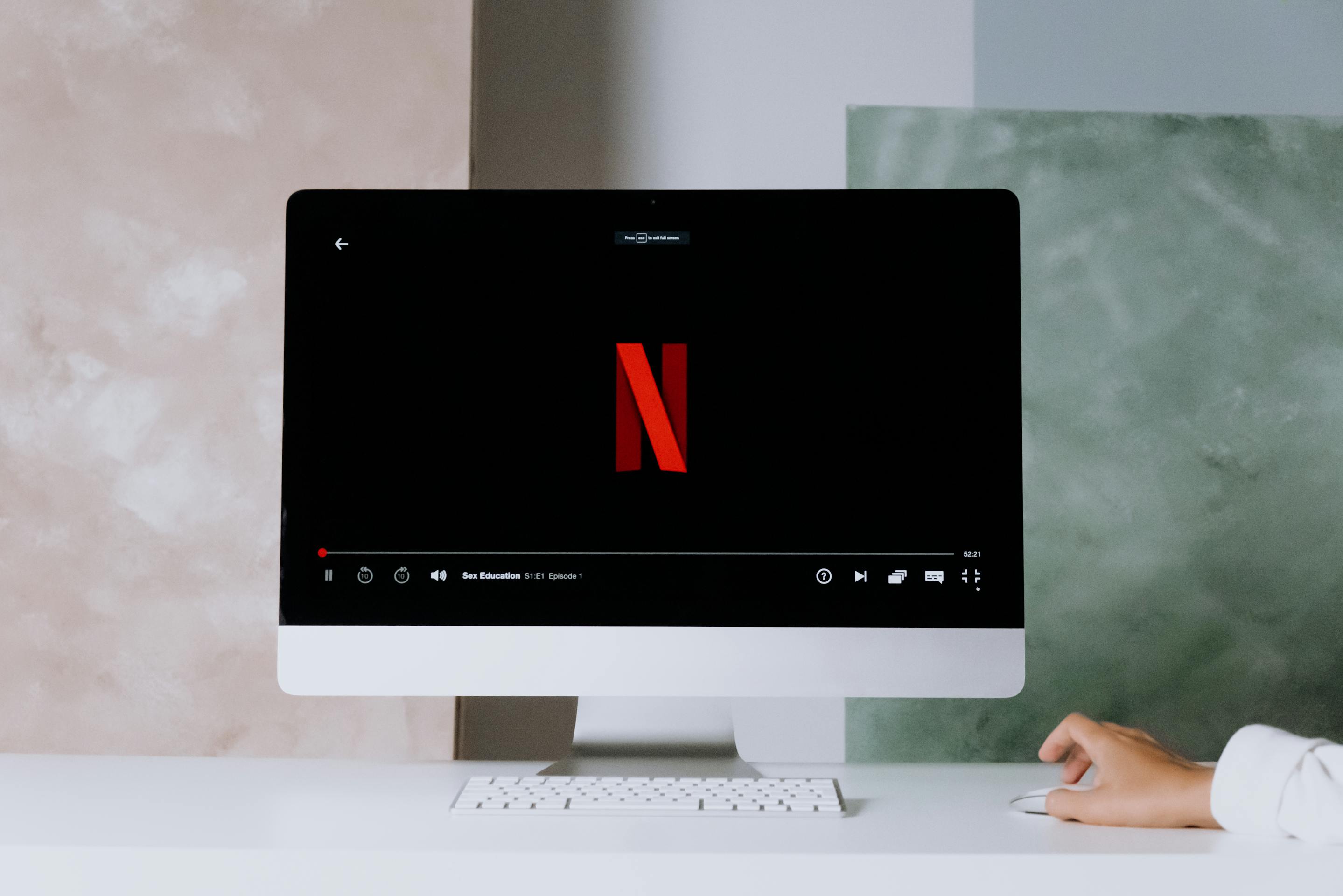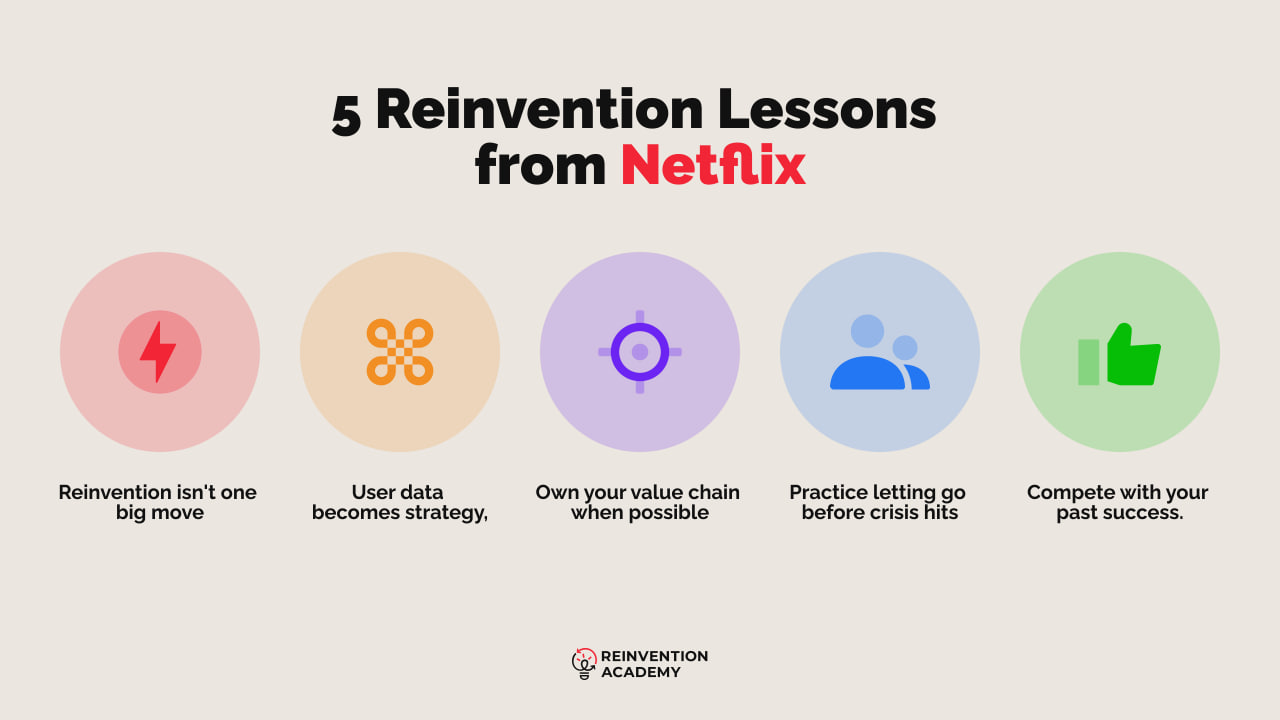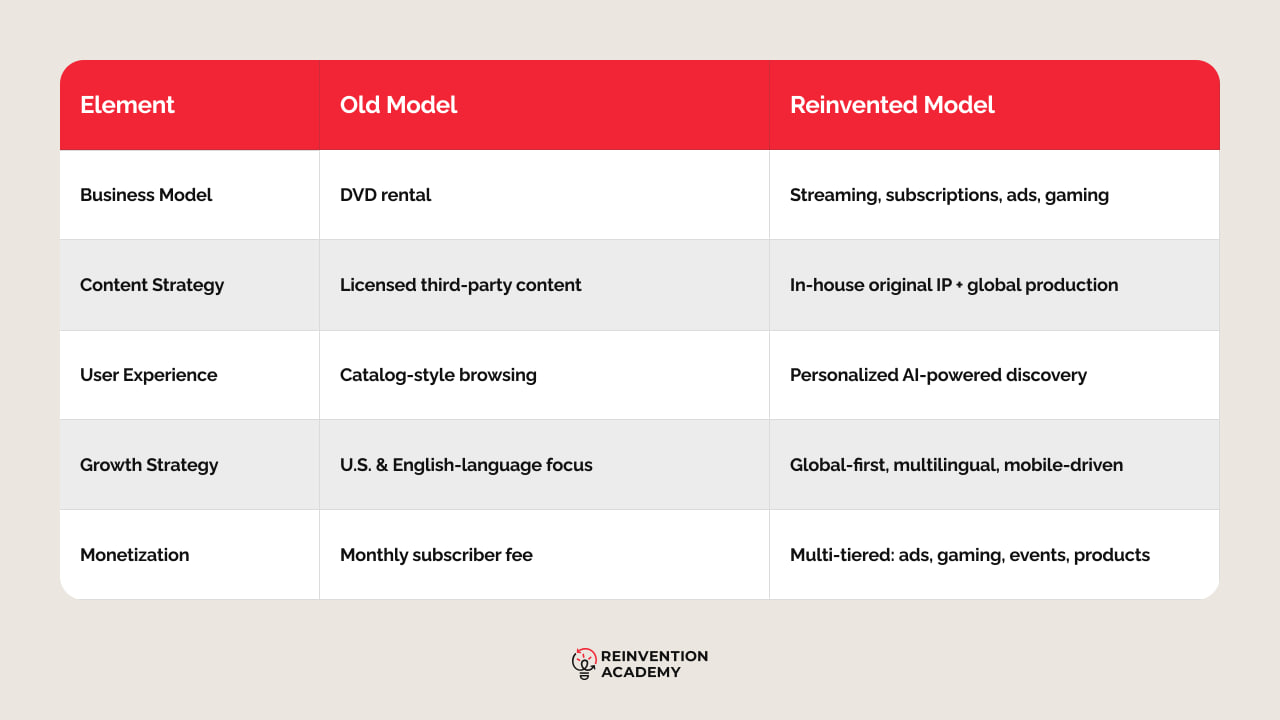Ditched DVDs for Global Domination: The Ultimate Netflix Case Study on Strategic Reinvention
Learn how Netflix reinvented itself from DVD rental to a streaming giant to an interactive entertainment platform through bold strategies and data-driven decisions.

Netflix, Inc. (NFLX) is a global streaming entertainment service known for original series like Stranger Things and Squid Game, plus interactive content and mobile gaming. Founded in 1997 by Reed Hastings and Marc Randolph as a DVD rental service, the company now serves over 301.6 million subscribers worldwide. Netflix generated $39 billion in revenue during 2024 and employs approximately 13,000 people globally.
Here's the thing about Netflix's reinvention strategy: Most companies reinvent once and call it good; Netflix has made continuous reinvention its operating system. The Netflix case study shows how a business can proactively shed what works before it stops working. Dr. Nadya Zhexembayeva's framework fits Netflix perfectly: they let go of DVDs, aligned with streaming, then dumped pure licensing for originals, and now they're building gaming and ad-supported experiences. Netflix didn't wait for disruption. They became “the disruption.”
Why Netflix Needed Reinvention
Netflix faced obsolescence not once, but twice. The company started by disrupting Blockbuster's DVD rental dominance through mail-order service. Smart move. However, streaming technology quickly rendered DVDs obsolete. Streaming platform innovation became essential for survival, not growth.
Then something unexpected happened. Success created new problems. Competitors like Disney+ and HBO Max copied Netflix's streaming platform innovation approach. Market saturation hit key regions, leading to slower subscriber growth. Content licensing costs exploded. Account sharing ate into profits. Password crackdowns only went so far.
Netflix’s business model transformation became a must as the rate of subscriber growth slowed to 5.1 million in Q3 2024 from 8.8 million in 2023. The North American market only added 0.69 million subscribers, while the Asia-pacific market saw a growth of 2.28 million. The message was clear. Netflix needed fresh revenue streams and deeper engagement beyond passive viewing.
Netflix's Reinvention Strategy: Platform, Ownership, and Expansion
Netflix's reinvention strategy targeted three major areas simultaneously:
1. Platform Evolution and Tiered Monetization
Netflix's ad-supported tier launched in November 2022 due to subscriber saturation. The results were positive; Netflix’s revenue doubled in 2024, and the US streamer is optimistic it will double again in 2025. The ad tier now boasts 70 million monthly active users (MAUs), more than the entire subscriber base of Hulu or Apple TV+.
Over 55% of new signups in countries with the ad tier choose this cheaper option. Netflix also focused on mobile-first access for international markets, especially regions with lower household incomes.
The platform spent heavily on personalized UI and content curation. Over 80% of the content watched by users on Netflix is because of its algorithm. It makes use of per-user trends, such as how long a user is watching any particular show, whether they are pausing it midway, completing it, etc. This intelligence leads to better personalization and saves Netflix over $1 billion a year by helping to retain subscribers longer and having fewer unsubscribes. This personalization makes people less likely to leave the platform.
2. Owning the Pipeline: Originals and IP
Netflix moved from licensing third-party content to creating it. Netflix's original programming strategy created globally appealing hits with export value. Shows like Money Heist, Narcos, and Squid Game showed that non-English content can top viewership charts worldwide.
The company established Netflix production studios and local production hubs across continents. Netflix invested heavily in local creators and multilingual storytelling, recognizing that authentic regional content travels globally better than dubbed American shows. This strategy gave Netflix authority over content costs, timing of distribution, and ownership of IP while building cultural credibility. Netflix's content strategy focused on building “universes” that could go beyond a show, enabling merchandise, games, and live events.
3. Beyond Video: Gaming, Interactivity, and Immersion
Netflix gaming strategy is the boldest expansion yet. Netflix Games launched in November 2021 to improve loyalty and usage beyond their early passive viewing. After investing $1 billion and closing its AAA studio in October 2024, Netflix shifted its focus and adopted a four-pillar approach to games: mainstream, narrative, kids, and party games.
Netflix tried out interactive formats and gamified experiences through Black Mirror: Bandersnatch, which allows viewers to make choices and influence story outcomes. The company developed IP universes and extensions into merchandise, mobile games, and live events. Games like Stranger Things and Too Hot to Handle based on Netflix IP allow for engagement with content while giving Netflix an additional revenue stream. In several markets, Netflix is testing cloud games on TV, providing consumers with more options for gaming.
Two Enablers That Powered the Reinvention
While competitors scrambled to copy Netflix's moves, two internal systems made those strategies actually work.
1. Culture of Continuous Reinvention
The Netflix reinvention strategy works because leadership openly discusses abandoning successful models before they fail. The company uses data to iterate, cancel shows, or double down on winners quickly.
Netflix uses engagement metrics like total hours viewed, frequency of sessions, and monthly retention rates as KPIs for the platform rather than just total subscriber count. These metrics help determine where to invest in content, how to optimize recommendations, and which features to build, as they better reflect the long‑term value and satisfaction being delivered to each subscriber.
2. End-to-End Content Infrastructure
Vertical control gives Netflix flexibility in pricing, distribution, and IP development. Internal studios create resilience against external licensing cost volatility. The data loop from viewership to production informs greenlighting decisions and investment priorities.
Netflix production studios do not just produce content. They develop data-driven content pipelines that enable them to predict audience demand before the audiences themselves know what they want. It becomes harder for rivals to catch up to Netflix’s infrastructure as it expands.

Dr. Nadya Zhexembayeva's Reinvention Lens on Netflix
Netflix exemplifies Dr. Zhexembayeva's reinvention philosophy perfectly. The company demonstrates continuous renewal rather than one-time change. Netflix case study shows four key alignment points:
- Let go: Moved beyond physical media, pure licensing, and subscriber-only models
- Aligned: Reoriented around tech-savvy, global-first audiences seeking personalized experiences
- Embedded change: Innovation became standard operating procedure across content, technology, and leadership
- Ecosystemized: Built integrated content, brand, and product systems rather than separate business units
Netflix didn't just stream content. They streamed continuous reinvention into entertainment industry practices.
5 Reinvention Lessons from Netflix for Business Leaders
- Reinvention isn't one big move. Netflix made bold steps consistently rather than betting everything on single changes. Small experiments informed bigger strategic shifts.
- Own your value chain when possible. Netflix production studios give the company control over costs, timing, and IP rights that licensing never provided.
- User data becomes strategy, not just analytics. Netflix uses viewing patterns to guide content investment, interface design, and product development decisions.
- Compete with your past success. Netflix's ad-supported tier cannibalized higher-priced subscriptions initially but created sustainable growth in price-sensitive markets.
- Practice letting go before crisis hits. Netflix abandoned DVDs while still profitable and moved beyond pure streaming before competitors commoditized the space.
Netflix Reinvention at a Glance

Final Credits: Why Netflix's Reinvention Keeps Playing
This Netflix case study tells us that reinvention isn't about jumping ahead; It's about staying ahead through continuous adaptation. Netflix stands out in crowded markets due to its willingness to challenge its own business models before the competition does.
Business leaders should ask themselves:
- Are we innovating before we need to?
- What's our Netflix original programming moment that differentiates us from copycats?
- Can we build systems that rewrite themselves proactively rather than reactively?
As Dr. Nadya Zhexembayeva puts it, "Either you are out, or you are building the type of organization that is reinventing proactively, on a regular basis, without being dragged through transformation against your will." Netflix's reinvention strategy shows that market leadership requires perpetual renewal, not just initial innovation.


.svg)